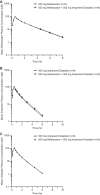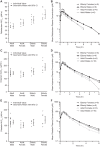Pharmacokinetics, Safety, and Tolerability of Single and Multiple Doses of Relebactam, a β-Lactamase Inhibitor, in Combination with Imipenem and Cilastatin in Healthy Participants
- PMID: 29914955
- PMCID: PMC6125551
- DOI: 10.1128/AAC.00280-18
Pharmacokinetics, Safety, and Tolerability of Single and Multiple Doses of Relebactam, a β-Lactamase Inhibitor, in Combination with Imipenem and Cilastatin in Healthy Participants
Erratum in
-
Erratum for Rhee et al., "Pharmacokinetics, Safety, and Tolerability of Single and Multiple Doses of Relebactam, a β-Lactamase Inhibitor, in Combination with Imipenem and Cilastatin in Healthy Participants".Antimicrob Agents Chemother. 2018 Nov 26;62(12):e02197-18. doi: 10.1128/AAC.02197-18. Print 2018 Dec. Antimicrob Agents Chemother. 2018. PMID: 30478180 Free PMC article. No abstract available.
Abstract
Relebactam is a novel class A and C β-lactamase inhibitor that is being developed in combination with imipenem-cilastatin for the treatment of serious infections with Gram-negative bacteria. Here we report on two phase 1 randomized, double-blind, placebo-controlled pharmacokinetics, safety, and tolerability studies of relebactam administered with or without imipenem-cilastatin to healthy participants: (i) a single-dose (25 to 1,150 mg) and multiple-dose (50 to 625 mg every 6 h [q6h] for 7 to 14 days) escalation study with men and (ii) a single-dose (125 mg) study with women and elderly individuals. Following single- or multiple-dose intravenous administration over 30 min, plasma relebactam concentrations declined biexponentially, with a terminal half-life (t1/2) ranging from 1.35 to 1.85 h independently of the dose. Exposures increased in a dose-proportional manner across the dose range. No clinically significant differences in pharmacokinetics between men and women, or between adult and elderly participants, were observed. Urine pharmacokinetics demonstrated that urinary excretion is the major route of relebactam elimination. No drug-drug interaction between relebactam and imipenem-cilastatin was observed, and the observed t1/2 values for relebactam, imipenem, and cilastatin were comparable, thus supporting coadministration. Relebactam administered alone or in combination with imipenem-cilastatin was well tolerated across the dose ranges studied. No serious adverse events or deaths were reported. The pharmacokinetic profile and favorable safety results supported q6h dosing of relebactam with imipenem-cilastatin in clinical treatment trials.
Keywords: pharmacokinetics; relebactam; β-lactamase inhibitor.
Copyright © 2018 Rhee et al.
Figures




Similar articles
-
Prospective, randomized, double-blind, Phase 2 dose-ranging study comparing efficacy and safety of imipenem/cilastatin plus relebactam with imipenem/cilastatin alone in patients with complicated urinary tract infections.J Antimicrob Chemother. 2017 Sep 1;72(9):2616-2626. doi: 10.1093/jac/dkx139. J Antimicrob Chemother. 2017. PMID: 28575389 Clinical Trial.
-
A Single- and Multiple-Dose Study To Characterize the Pharmacokinetics, Safety, and Tolerability of Imipenem and Relebactam in Healthy Chinese Participants.Antimicrob Agents Chemother. 2021 Feb 17;65(3):e01391-20. doi: 10.1128/AAC.01391-20. Print 2021 Feb 17. Antimicrob Agents Chemother. 2021. PMID: 33288637 Free PMC article.
-
Pharmacokinetics, Safety, and Tolerability of Imipenem/Cilastatin/Relebactam in Children with Confirmed or Suspected Gram-Negative Bacterial Infections: A Phase 1b, Open-Label, Single-Dose Clinical Trial.J Clin Pharmacol. 2023 Dec;63(12):1387-1397. doi: 10.1002/jcph.2334. Epub 2023 Sep 2. J Clin Pharmacol. 2023. PMID: 37562063 Clinical Trial.
-
Imipenem-Relebactam and Meropenem-Vaborbactam: Two Novel Carbapenem-β-Lactamase Inhibitor Combinations.Drugs. 2018 Jan;78(1):65-98. doi: 10.1007/s40265-017-0851-9. Drugs. 2018. PMID: 29230684 Review.
-
Imipenem-Cilastatin-Relebactam: A Novel β-Lactam-β-Lactamase Inhibitor Combination for the Treatment of Multidrug-Resistant Gram-Negative Infections.Pharmacotherapy. 2020 Apr;40(4):343-356. doi: 10.1002/phar.2378. Epub 2020 Mar 9. Pharmacotherapy. 2020. PMID: 32060929 Review.
Cited by
-
Imipenem/Cilastatin/Relebactam Alone and in Combination against Pseudomonas aeruginosa in the In Vitro Pharmacodynamic Model.Antimicrob Agents Chemother. 2020 Nov 17;64(12):e01764-20. doi: 10.1128/AAC.01764-20. Print 2020 Nov 17. Antimicrob Agents Chemother. 2020. PMID: 33139283 Free PMC article.
-
Population Pharmacokinetic Analysis for Imipenem-Relebactam in Healthy Volunteers and Patients With Bacterial Infections.CPT Pharmacometrics Syst Pharmacol. 2019 Oct;8(10):748-758. doi: 10.1002/psp4.12462. Epub 2019 Oct 4. CPT Pharmacometrics Syst Pharmacol. 2019. PMID: 31508899 Free PMC article.
-
Activity of Imipenem-Relebactam and Meropenem-Vaborbactam against Carbapenem-Resistant, SME-Producing Serratia marcescens.Antimicrob Agents Chemother. 2020 Mar 24;64(4):e02255-19. doi: 10.1128/AAC.02255-19. Print 2020 Mar 24. Antimicrob Agents Chemother. 2020. PMID: 31932381 Free PMC article.
-
Imipenem/Cilastatin/Relebactam: A Review in Gram-Negative Bacterial Infections.Drugs. 2021 Feb;81(3):377-388. doi: 10.1007/s40265-021-01471-8. Epub 2021 Feb 25. Drugs. 2021. PMID: 33630278 Free PMC article. Review.
-
Imipenem/cilastatin/relebactam efficacy, safety and probability of target attainment in adults with hospital-acquired or ventilator-associated bacterial pneumonia among patients with baseline renal impairment, normal renal function, and augmented renal clearance.JAC Antimicrob Resist. 2023 Mar 4;5(2):dlad011. doi: 10.1093/jacamr/dlad011. eCollection 2023 Apr. JAC Antimicrob Resist. 2023. PMID: 36880088 Free PMC article.
References
-
- Karlowsky JA, Hoban DJ, Hackel MA, Lob SH, Sahm DF. 2017. Antimicrobial susceptibility of Gram-negative ESKAPE pathogens isolated from hospitalized patients with intra-abdominal and urinary tract infections in Asia-Pacific countries: SMART 2013–2015. J Med Microbiol 66:61–69. doi:10.1099/jmm.0.000421. - DOI - PubMed
-
- Karlowsky JA, Hoban DJ, Hackel MA, Lob SH, Sahm DF. 2017. Resistance among Gram-negative ESKAPE pathogens isolated from hospitalized patients with intra-abdominal and urinary tract infections in Latin American countries: SMART 2013–2015. Braz J Infect Dis 21:343–348. doi:10.1016/j.bjid.2017.03.006. - DOI - PMC - PubMed
-
- Weiner LM, Fridkin SK, Aponte-Torres Z, Avery L, Coffin N, Dudeck MA, Edwards JR, Jernigan JA, Konnor R, Soe MM, Peterson K, McDonald LC. 2016. Vital signs: preventing antibiotic-resistant infections in hospitals—United States, 2014. MMWR Morb Mortal Wkly Rep 65:235–241. doi:10.15585/mmwr.mm6509e1. - DOI - PubMed
Publication types
LinkOut - more resources
Full Text Sources
Other Literature Sources

